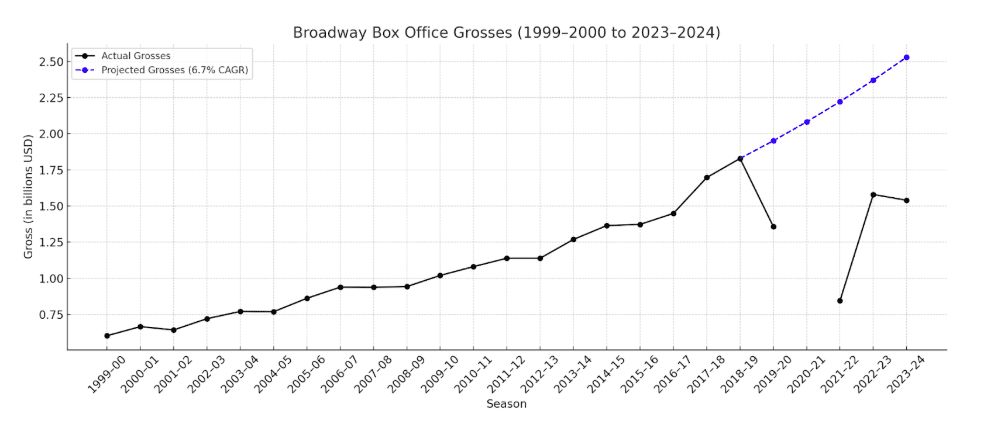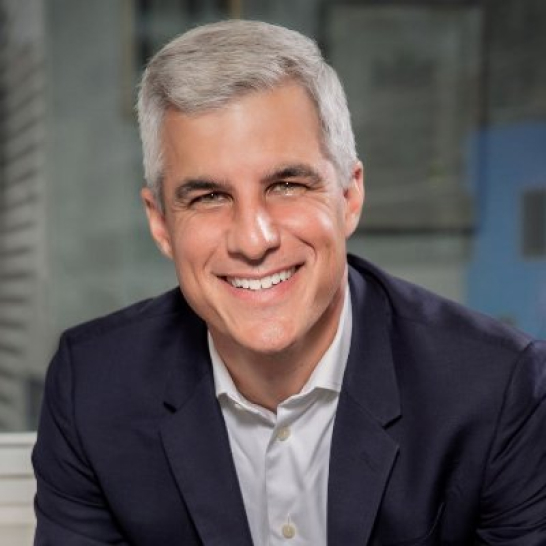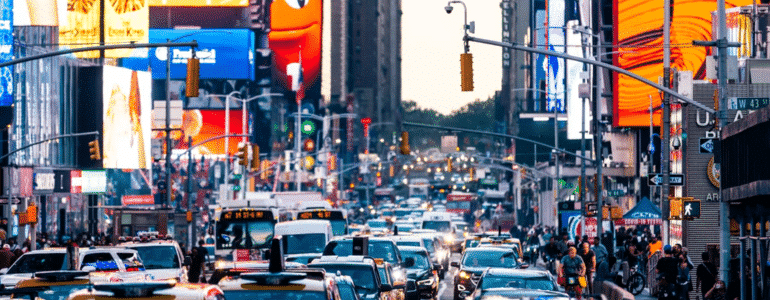What Broadway Would Have Looked Like Without the Pandemic
My therapist tells me to look ahead. The past is the past, and if you can’t change it, then don’t dwell on it. Focus on the present. Focus on what you can change today to make a better tomorrow.
Easier said than done, of course (which is why I’m still in therapy!) – especially on the recent fifth anniversary of the most cataclysmic event the modern theatre has ever faced – the COVID-19 pandemic.
That’s why I couldn’t help but want to take a DeLorean back a few years and imagine what Broadway would have looked like if that virus hadn’t wreaked havoc on the entire world and our industry.
More specifically, I wondered . . .
What would Broadway be grossing right now, if Covid hadn’t taken that bite out of our box office?
We all talk about how our industry is doing compared to our last full season in 2018-19. We’ve measured our comeback against that benchmark. But to really demonstrate how much of an impact the pandemic had on our industry, and to demonstrate to others (like the politicians in our state considering the extension of Governor Hochul’s essential Broadway tax credit) I wanted to compare our current Broadway grosses with what they would have been if the pandemic had not occurred at all.
I started by calculating our annual Broadway gross growth rate using the CAGR formula in the twenty seasons prior to the pandemic.
Here’s what I got:
In the past twenty Broadway seasons, our grosses have grown by an average of 6.01% each year.
Next, I took our season-ending gross in 2018-19 and extrapolated it to the 2023-24 season using that 6.01% growth rate, to calculate where we WOULD have been had our grosses continued at that same twenty-year average.
The answer?
Our 2023-24 season gross should have been $2.45 billion.
Our actual gross rate for the 2023-24 season was . . . $1.54 billion.
That’s a difference of $910 million.
Yes, you read that correctly. We are missing $910 million.
(Insert “gulp” here.)
What’s worse . . . if we look at the average growth in the last ten years instead of twenty, we get an average yearly increase of 6.7% instead of 6.01%. Taking the position that our grosses would have continued to grow at this higher rate (which is a very valid argument, given how much technology, among other factors, has helped us in the last ten years), the gross in 2023-24 would have been . . . $2.53 billion.
Comparing that to the gross of $1.54 billion in 2018-19?
We’re missing $990 million.
That’s right – just under ONE BILLION DOLLARS.
That’s a billion dollars that would be spread out amongst authors, designers, directors, actors, investors, vendors, and everyone who makes shows happen night after night after night.
This also means our city, its restaurants, cabs, hotels, and more are missing the economic impact of that BILLION dollars.
Let’s look at a graph of where our gross should be, using that 10-year growth rate of 6.7%, compared to where we actually are:

To put a sour cherry on the top of this sundae . . . over the last four years, the average inflation rate in the US has more than doubled, compared to the previous four. And, we all know that Broadway’s costs increase at a rate greater than the average. In some cases, Broadway’s costs have gone up as much as 30%.
This one-two punch of the missing billion dollars plus this extreme Broadway inflation is the reason why profitability has been—ahem—challenged since the pandemic . . . and will continue to be – until two things occur:
- Our grosses catch up . . . not to 2018-19 levels . . . but to where we SHOULD be.
- Our costs come down . . . NOT to 2018-19 levels (those would be too low) . . . but to where they should be.
Ready for some good news? (About time, right?)
THIS season, 2024-25, we have bucked a historical trend of being down in an election/olympics/leap year . . . and are up . . . big time.
As of the week ending March 23rd, our grosses are up more than 19% (!) this season over the previous season – which is the highest growth we’ve seen in the last twenty years. It’s almost 3x the average growth rate of 6.70% we used in our calculations above. And the season isn’t done. (I’m predicting we’ll get to 20%).
And that massive growth is based on an average ticket price of $127.61 overall Broadway shows, which is only 3.02% higher than the 2018-19 average ticket price of $123.87. (So yes, those big star-driven shows may have big ticket prices, but ALL of Broadway isn’t seeing some massive price increase. In fact, the average ticket price is behind inflation.)
(SIDE NOTE: A big shout-out to those helping with this double-digit growth . . . including Wicked and its Producers David Stone & Universal who brought massive attention and dollars to our industry with their phenom that is the Wicked movie, Producers like Greg Nobile, Sonia Friedman, Brian Moreland and others, who have produced such a high volume of shows in such a high-risk environment; big stars like Denzel Washington, George Clooney, Idina Menzel, Nick Jonas, Sarah Snook and more who tell the world how important live theater is when they grace our stages, etc.).
Now . . . If, IF, we could somehow continue that 19% growth? Well, we’d be back to our normal trend line in about under three years.
Of course, that kind of growth year over year is almost impossible. (We may not have the seating capacity for it – we only have forty-one theaters after all!)
So what if this season averaged that 20% gross that I’m predicting, and the following years averaged 8% (still an above-average but more “normal” increase)?
In that case, it would take just over five seasons for a full correction.
What does all this mean?
Broadway is coming back and it’s coming back with a vengeance . . . but a complete and full recovery is going to take longer than any one of us would like.
This is why New York State must pass Governor Hochul’s proposed extension of the New York City Musical and Theatrical Production Tax Credit.
Because Broadway, the City, the State, and all of its theatermakers, are a billion dollars behind. The only way we catch up is to keep creating and producing show after show after show until our audience gets back in the habit again.
And the tax credit is one of the primary driving forces behind the unprecedented growth that we are seeing this year. It’s an insurance policy for producing when our grosses are this far behind.
We’ll work on lowering costs. We’ll work on getting more butts in seats. And we must also work on keeping our ticket prices affordable and accessible.
And we will get there.
But we are going to continue to need support from our local and state governments to do so.
Because Broadway can’t just afford to be “back” – we have to be back on track.
And now, I’ll take my therapist’s advice, and start only thinking about the future and say . . . I look forward to writing a follow-up article when we get there.
Podcasting
Ken created one of the first Broadway podcasts, recording over 250 episodes over 7 years. It features interviews with A-listers in the theater about how they “made it”, including 2 Pulitzer Prize Winners, 7 Academy Award Winners and 76 Tony Award winners. Notable guests include Pasek & Paul, Kenny Leon, Lynn Ahrens and more.













